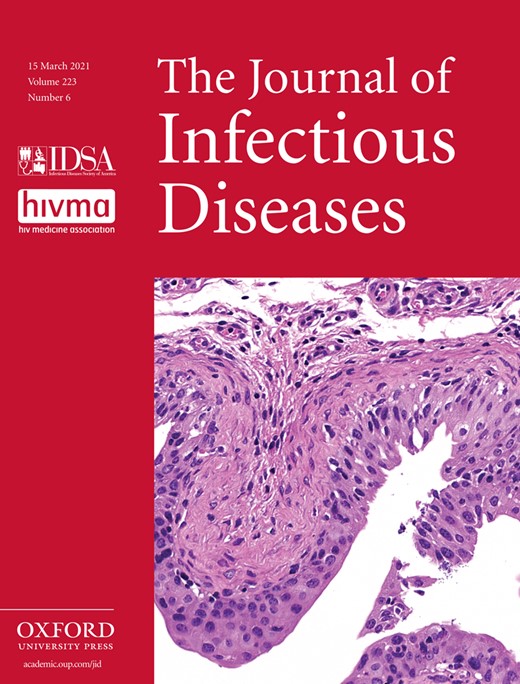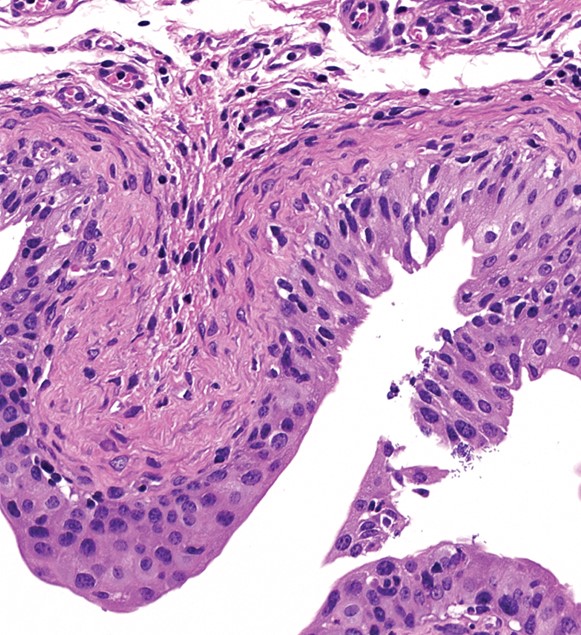
Cover image

Volume 223, Issue 6, 15 March 2021
EDITORIAL COMMENTARIES
Prevalence of Antimalarial Resistance Mediators
Wave the Yellow Flag: Why We Should Prioritize Routine Human Immunodeficiency Virus and Sexually Transmitted Infection Care Now
MAJOR ARTICLES AND BRIEF REPORTS
COVID-2019
Association of Neutrophil Activation, More Than Platelet Activation, With Thrombotic Complications in Coronavirus Disease 2019
Platelets and neutrophils are activated in patients with coronavirus disease 2019. Increased neutrophil extracellular trap biomarkers are particularly associated with venous thromboembolism thrombotic events and may help predict clinical worsening and venous thromboembolism and guide low-molecular-weight heparin treatment.
Natural History of Coronavirus Disease 2019: Risk Factors for Hospitalizations and Deaths Among >26 Million US Medicare Beneficiaries
This observational study quantified the degree of elevated risk of coronavirus disease 2019–associated deaths and hospitalizations among elderly Medicare beneficiaries who were older, male, of lower socioeconomic status, or immunocompromised or who had comorbid conditions. Risk was also substantially higher among nursing home residents and those with end-stage renal disease.
Role of Immunoglobulin M and A Antibodies in the Neutralization of Severe Acute Respiratory Syndrome Coronavirus 2
Immunoglobulin (Ig) M, IgG1, and IgA1 antibodies against severe acute respiratory syndrome coronavirus 2 spike glycoprotein and its receptor-binding domain are present in plasma from patients with convalescent coronavirus disease 2019 (COVID-19). IgG, IgM, and IgA contribute to virus neutralization, providing the basis for optimal selection of convalescent plasma for COVID-19 treatment.
Severe Acute Respiratory Syndrome Coronavirus 2 Serosurveillance in a Patient Population Reveals Differences in Virus Exposure and Antibody-Mediated Immunity According to Host Demography and Healthcare Setting
A serial cross-sectional serosurvey among primary and secondary care patients in Glasgow, Scotland, shows low seroprevalence during the first wave of the coronavirus disease 2019 pandemic and identifies age, sex and care type as factors associated with increased probability of infection.
Fostamatinib Inhibits Neutrophils Extracellular Traps Induced by COVID-19 Patient Plasma: A Potential Therapeutic
PARASITES
Changing Prevalence of Potential Mediators of Aminoquinoline, Antifolate, and Artemisinin Resistance Across Uganda
The prevalence of genetic polymorphisms associated with antimalarial drug resistance in Plasmodium falciparum collected from 16 sites across Uganda was studied. Most concerning was increasing prevalence of mutations associated with resistance to antifolates and artemisinins.
School-Based Serosurveys to Assess the Validity of Using Routine Health Facility Data to Target Malaria Interventions in the Central Highlands of Madagascar
Using school-based serological surveys as a gold standard for transmission intensity a low-transmission area of Madagascar, annual parasite incidence from routine health facility malaria data performed reasonably well at identifying higher-transmission communes, but sensitivity declined at lower transmission levels.
Under the Radar: Epidemiology of Plasmodium ovale in the Democratic Republic of the Congo
Plasmodium ovale is present and broadly distributed throughout the Democratic Republic of Congo (DCR) at an estimated prevalence of 0.8%. Both species, P. ovale wallikeri and P. ovale curtisi, were identified as occurring throughout the DRC.
Molecular Evidence for Local Acquisition of Human Alveolar Echinococcosis in Saskatchewan, Canada
HIV/AIDS
Projected HIV and Bacterial Sexually Transmitted Infection Incidence Following COVID-19–Related Sexual Distancing and Clinical Service Interruption
The transmission model of HIV, gonorrhea, and chlamydia among men who have sex with men in the Atlanta area demonstrates the impact of changes to sexual behavior and disruptions to HIV/STI clinical services in response to the COVID-19 pandemic.
Alcohol Use Is Associated With Intestinal Dysbiosis and Dysfunctional CD8+ T-Cell Phenotypes in Persons With Human Immunodeficiency Virus
Alcohol use is prevalent among persons with HIV and is associated with T-cell late differentiation. Intestinal dysbiosis accompanies alcohol use. A relative intestinal bloom in members of the bacterial Prevotellaceae family may underlie alcohol-associated CD8+ T-cell senescence.
PATHOGENESIS AND HOST RESPONSE
Uropathogenic Escherichia coli Virulence Factor α-Hemolysin Reduces Histone Acetylation to Inhibit Expression of Proinflammatory Cytokine Genes
Uropathogenic Escherichia coli virulence factor HlyA inactivates AKT/ACLY signaling pathways, which decreased acetyl-CoA level, leading to reduced H3K9 histone acetylation and the expression of proinflammatory genes. These effects were reversed by exogenous acetate.
Human Respiratory Syncytial Virus-Induced Immune Signature of Infection Revealed by Transcriptome Analysis of Clinical Pediatric Nasopharyngeal Swab Samples
This study applied a tailored transcriptomics workflow to exploit nasal wash samples from HRSV-positive hospitalized children. The transcriptional immune signature appears as a direct reflection of HRSV pathogenesis and highlights putative biomarkers of interest.
VIRUSES
Broad Antibody and Cellular Immune Response From a Phase 2 Clinical Trial With a Novel Multivalent Poxvirus-Based Respiratory Syncytial Virus Vaccine
The novel multivalent RSV vaccine MVA-BN-RSV, based on the MVA-BN vector, induces a broad antibody and cellular immune response in older adults that persists at least 6 months and can be boosted at 12 months, without significant safety findings.
Risk Factors for Cytomegalovirus Viremia following Liver Transplantation With a Seropositive Donor and Seronegative Recipient Receiving Antiviral Therapy
Older donor age is independently associated with cytomegalovirus viremia and earlier onset of viremia in high-risk donor-positive recipient-negative liver transplant recipients.
Relative Severity of Common Human Coronaviruses and Influenza in Patients Hospitalized With Acute Respiratory Infection: Results From 8-Year Hospital-Based Surveillance in Quebec, Canada
Common human coronaviruses were less frequent than influenza in children and adults hospitalized with acute respiratory infections but generated significant morbidity. Length of stay, intensive care unit admissions, and case-fatality ratio were comparable for both types of monoinfection.
Factors Associated With Viral Load Kinetics of Middle East Respiratory Syndrome Coronavirus During the 2015 Outbreak in South Korea
This retrospective study examines the viral load kinetics and the correlation between disease outcome and other epidemiological parameters among 185 patients hospitalized with Middle East respiratory syndrome coronavirus (MERS-CoV) infection during the 2015 MERS-CoV outbreak in South Korea.
BACTERIA
Peptidylarginine Deiminases 2 Mediates Caspase-1-Associated Lethality in Pseudomonas aeruginosa Pneumonia-Induced Sepsis
Pad2 −/− mice exhibited improved survival, attenuated lung injury, and enhanced bacterial clearance during Pseudomonas aeruginosa pneumonia-induced sepsis. The protective effects are probably associated with the regulatory effects of PAD2 on caspase-1-dependent pyroptosis.
PRIONS
Porcine Prion Protein as a Paradigm of Limited Susceptibility to Prion Strain Propagation
Experimental transmission in pig cellular prion protein (PrPC) transgenic mice and in vitro protein misfolding cyclic amplification propagation assay results showed that pig-PrPC is resistant to all tested prion strains except classic bovine spongiform encephalopathy, and it may constitute a paradigm of low susceptibility to prion strain diversity.



